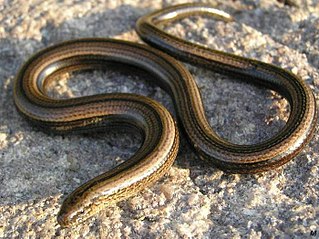
The Chamaesaura, also known as grass lizards, are a genus of legless lizards from southern and eastern Africa. The limbs are reduced to small spikes. Chamaesaura propel themselves like snakes, pushing against contact points in the environment, such as rocks, plants and irregularities in the soil. They are viviparous and eat small invertebrates, especially grasshoppers.
Feylinia boulengeri is an African lizard in the family Scincidae commonly known as skinks.
Feylinia is a genus of skinks. It is usually placed in the monotypic subfamily Feylininae.

Legless lizard may refer to any of several groups of lizards that have independently lost limbs or reduced them to the point of being of no use in locomotion. It is the common name for the family Pygopodidae, but often refers to other groups, such as limbless anguids, depending on the region of the world. These lizards are often distinguishable from snakes on the basis of one or more of the following characteristics: possessing eyelids, possessing external ear openings, lack of broad belly scales, notched rather than forked tongue, having two more-or-less-equal lungs, and/or having a very long tail.

Calocedrus formosana is a conifer endemic to Taiwan.

Calocedrus macrolepis is a conifer native to southwest China, northern Vietnam, northern Laos, extreme northern Thailand and northeastern Myanmar.

Guana Island is an island of the British Virgin Islands (BVI) in the Caribbean. One of the few remaining privately owned islands in its part of the world, Guana has seven white powder-sand beaches and 850 acres (3.4 km2) of tropical forest, mountains, hills, and valleys. The island is mostly natural preserve and has a small resort.

Little Camanoe is an uninhabited island of the British Virgin Islands in the Caribbean.

West Dog Island is an uninhabited islet of the British Virgin Islands in the Caribbean. It is located in a smaller sub-group of islands referred to as the Dog Islands, or more commonly, "The Dogs". Other islets in The Dogs include Little Seal Dog Island, East Seal Dog Island and George Dog Island, all of which are to the northwest of Virgin Gorda.
The large-scale grass lizard, also known as the large-scaled snake lizard, Zambian grass lizard, or Zambian snake lizard, is a species of lizard in the genus Chamaesaura. It lives scattered across southern Africa with two subspecies.

Utricularia scandens is a small, probably annual carnivorous plant that belongs to the genus Utricularia. It has a wide native distribution that includes Africa and Asia. U. scandens grows as a terrestrial plant in wet grasslands and bogs at lower altitudes around sea level up to 2,300 m (7,546 ft). It was originally described by Ludwig Benjamin in 1847. There is a significant amount of synonymy established for this species, in part because of its large distribution and variable morphology.
Limnerpeton is an extinct genus of dissorophoidean euskelian temnospondyl within the family Amphibamidae.

Sphaerodactylus macrolepis, also known as the big-scaled least gecko, big-scaled dwarf gecko, or cotton ginner, is a gecko distributed in the United States Virgin Islands and the British Virgin Islands and Culebra, Puerto Rico in the Caribbean. It is one of over 100 species in the genus Sphaerodactylus.

Quercus macrolepis, the Valonia oak, the old name for Quercus ithaburensis subsp. macrolepis.
The large-scaled banded gecko is a species of lizard in the family Gekkonidae. It is found in South Africa.
Mattauschia is an extinct genus of trematopid temnospondyls from the Late Carboniferous of the Czech Republic.
Feylinia currori, the western forest feylinia, is an African lizard in the family Scincidae commonly known as skinks. It is found in Nigeria, Cameroon, Gabon, Democratic Republic of the Congo, Republic of Congo, northern Angola, Central African Republic, Tanzania, and Kenya.
Feylinia elegans, the elegant feylinia, is an African lizard in the family Scincidae commonly known as skinks. It is found in Equatorial Guinea, Republic of the Congo, Democratic Republic of the Congo, northernmost Angola, and Central African Republic.
The large-scaled burrowing skink is an African lizard in the family Scincidae commonly known as skinks. It is found in Cameroon, Gabon, Angola, and Central African Republic.








